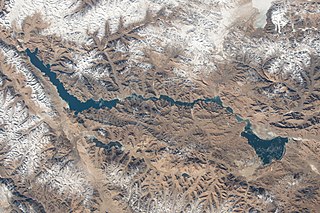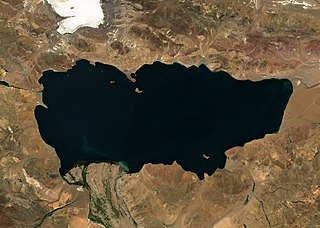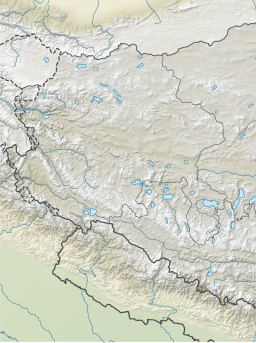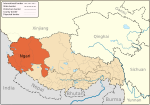
Tibet is a region in East Asia covering much of the Tibetan Plateau spanning about 2,500,000 km2 (970,000 sq mi). It is the traditional homeland of the Tibetan people as well as some other ethnic groups such as Monpa, Tamang, Qiang, Sherpa and Lhoba peoples and is now also inhabited by considerable numbers of Han Chinese and Hui people. Tibet is the highest region on Earth, with an average elevation of 4,380 m (14,000 ft). Located in the Himalayas, the highest elevation in Tibet is Mount Everest, Earth's highest mountain, rising 8,848.86 m (29,032 ft) above sea level.

Cho Oyu is the sixth-highest mountain in the world at 8,188 metres (26,864 ft) above sea level. Cho Oyu means "Turquoise Goddess" in Tibetan. The mountain is the westernmost major peak of the Khumbu sub-section of the Mahalangur Himalaya 20 km west of Mount Everest. The mountain stands on the China–Nepal border.

Pangong Tso or Pangong Lake is an endorheic lake spanning eastern Ladakh and West Tibet situated at an elevation of 4,225 m (13,862 ft). It is 134 km (83 mi) long and divided into five sublakes, called Pangong Tso, Tso Nyak, Rum Tso and Nyak Tso. Approximately 50% of the length of the overall lake lies within Tibet in China, 40% in Ladakh, India and the remaining 10% is disputed and is a de-facto buffer zone between India and China. The lake is 5 km (3.1 mi) wide at its broadest point. All together it covers almost 700 km2. During winter the lake freezes completely, despite being saline water. It has a land-locked basin separated from the Indus River basin by a small elevated ridge, but is believed to have been part of the latter in prehistoric times.
Tibetan Americans are Americans of Tibetan ancestry. As of 2020, more than 26,700 Americans are estimated to have Tibetan ancestry. The majority of Tibetan Americans reside in Queens, New York.

Semo La is a mountain pass situated in Coqên County, Ngari Prefecture in the central part of Tibet and gives access to the Changtang region. It is found on the so-called Northern Route, north of Raka and south of Town of Coqên in Central Tibet. Travellers use this route as an alternative access route to western Tibet and Mount Kailash, especially when mud makes access by the more southern route difficult.

Gurudongmar Lake is one of the highest lakes in the world and in India, at an elevation of 5,430 m (17,800 ft) according to the Government of Sikkim. It is located in the Great Himalayas in the Mangan District in Indian state of Sikkim, and considered sacred by Buddhists, Sikhs and Hindus. The lake is named after Guru Padmasambhava—also known as Guru Rinpoche—founder of Tibetan Buddhism, who visited in the 8th century.
In Tibetan culture and Sherpa culture, Dawa is a word meaning "moon" or "month". It is often used as a name for children born on a Monday. The name can be given to either a girl or a boy. Other people in the Himalayan region such as the Ladakhis, the Sikkimese of Northeast India and the Bhutanese people also use the name Dawa in the same sense as the Tibetans.

Coqên County is a county in the Ngari Prefecture, in the west of the Tibet Autonomous Region of China. It is the located in the southeast of Ngari Prefecture.
Raka is a village in Dênggar Township in Saga County in the Shigatse Prefecture of the Tibet Autonomous Region of China. It lies along the G219 road near the junction with the northern heading S206 road on the road to Qierexiang, roughly 50 kilometres (31 mi) east of Saga at an altitude of 5,565 metres (18,258 ft). Historically it lay in the province of Tsang. Raka is very well connected, connected by provincial highway 206 to Coqen in the north, Saga in the southwest and Lhatse, Shigatse and Lhasa to the east. Several kilometres to the east is the village of Kyêrdo. An "enormous tributary" called the Raka Tsanpo flows nearby and the saline lake of Raka Lake is also located in the vicinity.
Tongkor or Tongkhor Monastery, also known as Ganden Chokhorling or Dangar Gompa, is a Tibetan Buddhist monastery located in Zithang Town, Garzê County, Garzê Tibetan Autonomous Prefecture, Sichuan, China.
Ganglamedo is a 2006 musical movie from Tibet, (original name in Chinese 冈拉梅朵; ganglameiduo), directed by Dai Wei, written by Tashi Dawa.

Zhari Namco or Zhari Nanmu or Lake Trari Nam is a salt lake in Tibet, China. It is bounded on the west by the Ngari Prefecture of Coqên County, and on the east by the Ngamring County of Shigatse Prefecture. Zhari Namco is 996.9 square kilometres (384.9 sq mi), with a drainage area of 15,433.2 square kilometres (5,958.8 sq mi), an elevation of 4,613 metres (15,135 ft), length 54.3 kilometres (33.7 mi) and mean width 18.36 kilometres (11.41 mi). It is located east of Coqên Town in southern Tibet.

Jiesa Lake or Gyesar Tso is a lake in Coqên County in the Ngari Prefecture of the Tibet Autonomous Region of China. It is located southwest of Coqên Town. Fed by 27 small streams, it is 32.1 km long and 7.2 km wide and has an area of 146.4 square km.
Dajia Lake or Tak Kyel Tso, is a lake in Saga County in the Shigatse Prefecture of the Tibet Autonomous Region of China. It is located about half way between Lake Peiku and Zhari Namco, northeast of Saga.

Taruo Lake or Taruocuo, also known as Taro Tso is a lake in Zhongba County in the Shigatse Prefecture of the Tibet Autonomous Region of China. It is located about 70 kilometres west of Coqên Town. It is 38.1 km long and 17.2 km wide and has an area of 486.6 square km.
Vajara is Tibet's oldest and most famous rock and roll band. Founded in 1999 by six Tibetan people, the band creates modern music with elements from Tibetan opera, blues, and rap. Tenzin Dawa, the band's founder, was influenced by both Chinese rock acts such as Cui Jian and American rock bands like Nirvana but desired to forge a style separate from either genre. Vajara's songs are sung in both Tibetan and Chinese, with lyrical themes that address social issues such as greed and environmentalism. The band's main performing venue is a musical bar in Tibet's provincial capital of Lhasa.
The 1910 Chinese expedition to Tibet or the Chinese invasion of Tibet in 1910 was a military campaign of the Qing dynasty to establish direct rule in Tibet in early 1910. The expedition occupied Lhasa on February 12 and officially deposed the 13th Dalai Lama on the 25th.

Riyue Mountain, known in Tibetan as Nyima Dawa La, is actually a mountain pass situated in Huangyuan County, Xining, Qinghai Province, China. The mountain pass is 3,399 m (11,152 ft) above sea level and separates the Qinghai Lake endorheic basin from the Huangshui River basin, a tributary of the Yellow River. The Daotang River flows west from the pass into Qinghai Lake. The pass separates Qinghai Province into a pastoral zone in the west and an agricultural zone in the east.

The dpon-chen or pönchen, literally the "great authority" or "great administrator", was the chief administrator or governor of Tibet located at Sakya Monastery during the Yuan administrative rule of Tibet in the 13th and 14th centuries. In the Mongol Empire the office of the dpon-chen was established in the 1260s and functioned as the Tibetan government serving the Mongol emperors of the Yuan dynasty, unlike the Sakya Imperial Preceptors (Dishi) who were active at the Yuan court.
Tashi Dawa or Zhaxi Dawa, is a Chinese novelist of half-Tibetan half-Han ethnic background. He is a distinguished Tibetan writer in China, and one of the most controversial figures associated with modern Tibet. He is best known for his novel The Fury Shambhala and short stories "Souls Tied to the Knots on a Leather Cord" and "On the Road to Lhasa", which were adapted into a film Soul on a String in 2017. He is a member of the China Federation of Literary and Art Circles (CFLAC). He is a guest professor at Tibet Minzu University and Tibet University. His works have been translated into English, Dutch, French, German, Italian, Japanese, Czech, Russian, and Swedish.













